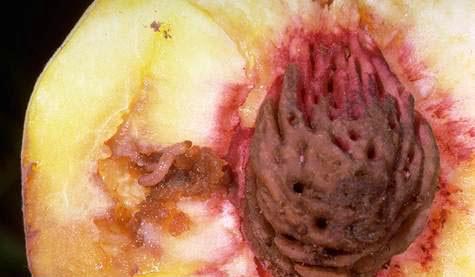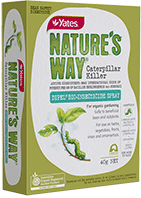| Organic Seeds | Edible Plants | Organic Pest Controls | Books | Tools, Propagation & Fertilisers | Sprouting & Microgreens | Poultry Supplies | Specials & Gift Ideas |

Top

We will send an email to this address*
when is next available
* we will use this email address only for this notification and then we will delete it.
 Home
Home
Green Harvest Organic Gardening Supplies is permanently closed as of 5pm on 1-11-2023.
We will not be taking orders by this website, in person, by phone or email. Our display garden and retail shop are closed forever.
Read more...
Phone:07 54357000
Phone calls will only be responded to sporadically and only in reference to orders placed prior to 2-11-2023. All the useful growing and organic pest management research and resources are available on this website for a while still.
 Oriental fruit moth (OFM) Cydia molesta is native to northwest China, it was introduced into eastern
Australia at the beginning of the 20th century, and so it has been here a long time and is well established.
Oriental fruit moth is also known as the peach tip moth and is a close relative of Codling moth Cydia
pomonella. It attacks the young shoots and fruit of stone fruit but quinces, pears and apples may also
be damaged.
Oriental fruit moth (OFM) Cydia molesta is native to northwest China, it was introduced into eastern
Australia at the beginning of the 20th century, and so it has been here a long time and is well established.
Oriental fruit moth is also known as the peach tip moth and is a close relative of Codling moth Cydia
pomonella. It attacks the young shoots and fruit of stone fruit but quinces, pears and apples may also
be damaged.Suggested Organic Strategies:
- Cut off and burn any infested twigs early in the season. Do this soon as wilting occurs and remove about 200 mm.
- Avoid planting late-ripening cultivars in areas with a significant problem, as this will increase the pest population that will overwinter.
- Remove loose bark and leaf debris from the trunk of the tree, to reduce hiding places for cocoons. Corrugated cardboard bands can be used to trap larvae (caterpillars) looking for a place to pupate. Put these around trunks before the end of December. Inspect regularly and kill any larvae or pupae.
- Remove and destroy any infested fruit every few days.
Organic Strategies for Oriental Fruit Moth Control © Frances Michaels
 Lifecycle
LifecycleThe adults are small, grey coloured moths. They are rarely seen in the orchard during the day, but may be seen in mating flights near the treetops in the very late afternoon on warm days (above 18°C). This could be any time from August to early November. After mating egg laying will occur on twigs and leaves. The eggs are small and round, cream in colour and about 0.7 mm in diameter.
The newly hatched larvae (caterpillars) burrow into the young succulent tip shoots to feed for up to four weeks during the spring. The young shoots soon wilt and collapse, producing gum as they die. The mature larva, which is now pinkish with a brown head, and about 12 mm long, searches for a suitable cocooning site, usually high in the tree near where it has been feeding. This larva spins a cocoon and pupates immediately, to emerge as an adult, between the middle of November and early January.
This second generation may attack shoots; green fruit or ripening fruit, depending on the hardness of the shoots and the stage the fruit is at. Often damage to ripening fruit is only noticed when the fruit is cut. The damage maybe confused with damage caused by codling moth or fruit fly. Depending on the area there can be 5-6 generations over the summer. The complete lifecycle in summer, from egg to adult, is about 33 days. Moths, caterpillars, eggs and pupae (cocoons) can all be present at the same time in an orchard from September to April.
The last summer generation of mature larvae search for a suitable hiding-place for the winter, usually under bark near the base of the tree or in leaf litter on the ground. When they have chosen their overwintering sites they spin their cocoons and stay in this state until late winter or early spring, when they emerge as moths.
Biological Controls
- The most important natural enemy of the Oriental fruit moth is native to Australia. It is an ichneumon wasp, the Oriental fruit moth parasite Glabridorsum stokesii, present in both VIC and NSW. Trichogramma micro-wasps are also important as they parasitise the moth eggs, by laying an egg inside the moth egg. The wasp larva then feeds on the contents of the moth egg. One female wasp is able to parasitise over 50 moth eggs. Trichogramma wasps are commercially produced in Australia. The adult micro-wasp feeds on insect eggs, nectar, and pollen, a good food supply means it lives longer. Growing suitable plants under the fruit trees as a pollen and nectar source helps to maintain a population of these beneficial insects. Suitable plants include clover, buckwheat, mustard, Queen Anne's lace, parsnip, daikon, alyssum, dill, coriander, cosmos and phacelia.
- Other natural enemies include tachinid flies, braconid wasps, chalcid wasps, carabid beetles, earwigs and ants. Spiders eat moth eggs, moths and larvae.
- Night flying birds, tree frogs and small insectivorous bats will also reduce moth numbers.
- Design your orchard area to be a poultry forage system, the chooks will turn damaged fruit into eggs and help to control a wide range of pests including Oriental fruit moth. Do not introduce poultry into a young orchard, as the poultry will scratch at the mulch, exposing the roots. Where it is undesirable to allow chooks free range, small demountable fences can be used under specific trees.
- Cut off and burn any infested twigs early in the season. Do this soon as wilting occurs and remove about 200 mm.
- Prune trees every year to avoid dense growth, as this growth will restrict the entry of small birds and other predators that will help in control.
- Thin the fruit to reduce the incidence of damage, as larvae more easily enter fruit that is touching another fruit.
- Avoid planting late-ripening cultivars in areas with a significant problem, as this will increase the pest population that will overwinter.
- Remove loose bark and leaf debris from the trunk of the tree, to reduce hiding places for cocoons. Corrugated cardboard bands can be used to trap larvae (caterpillars) looking for a place to pupate. Put these around trunks before the end of December. Inspect regularly and kill any larvae or pupae.
- Remove and destroy any infested fruit every few days.
- The spray window available when the larvae have hatched but are not yet inside the stem is very short and hard to predict accurately.
- Organically acceptable sprays to control caterpillars include Dipel based on Bacillus thuringiensis, or Bt for short.
- Least-toxic sprays. There will be some damage to populations of beneficial insects with the use of pyrethrum sprays.
- An oil spray can be used to smother the moth eggs, it should be applied 4 to 5 times beginning at petal fall and then at 10 day intervals.
- A pheromone is a non-toxic species-specific scent produced by the female insect to attract the male.
Pheromones are used to help in the control of OFM:
1. Pheromone sticky wing traps are used to monitor the mating activity of oriental fruit moth. They allow you to be aware of when the moths become active and correctly time your control program.
2. Oriental fruit moth can also be controlled by using pheromone ties. The slow release of pheromone into the orchard disrupts mating of the moths, thus reducing the number of fertile eggs produced. In peach and nectarine orchards, four ties should be placed on each tree by the first week in September. The ties need to be replaced in December.
 Dipel contains Bacillus
thuringiensis, or Bt for short; it is highly effective and selective against most species of caterpillars.
This biological control is a bacterial stomach poison for all caterpillars, which is mixed with water and sprayed
onto foliage. It must be ingested by the actively feeding caterpillar, which dies 3-5 days later. It is totally
safe to beneficial insects, bees and mammals. Bt is broken down by sunlight within a few days; so repeated
applications may be necessary.
Dipel contains Bacillus
thuringiensis, or Bt for short; it is highly effective and selective against most species of caterpillars.
This biological control is a bacterial stomach poison for all caterpillars, which is mixed with water and sprayed
onto foliage. It must be ingested by the actively feeding caterpillar, which dies 3-5 days later. It is totally
safe to beneficial insects, bees and mammals. Bt is broken down by sunlight within a few days; so repeated
applications may be necessary.
Suggested Products:
Dipel
Eco-Oil
Exclusion
Pyrethrum
 Home
Home
Green Harvest Organic Gardening Supplies is permanently closed as of 5pm on 1-11-2023.
We will not be taking orders by this website, in person, by phone or email. Our display garden and retail shop are closed forever.
Read more...
Phone:07 54357000
Phone calls will only be responded to sporadically and only in reference to orders placed prior to 2-11-2023. All the useful growing and organic pest management research and resources are available on this website for a while still.
No liability will be accepted by Green Harvest, its owners or employees as to the accuracy of any information. No responsibility will be taken for damage to property or persons due to information given about a product or technique. No responsibility will be taken for the loss of a crop or income due to information given about a product or technique.
 Shopping here is private and secure.
Shopping here is private and secure.
Copyright © 2001 - 2024 Green Harvest Organic Gardening Supplies
No part of this website may be reproduced without permission of the owner